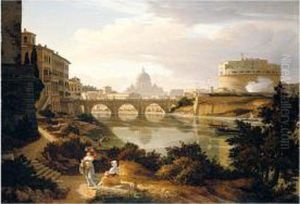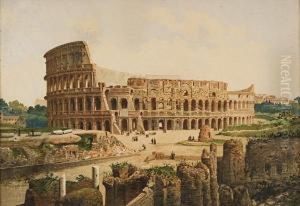Rudolf Wiegmann Paintings
Rudolf Wiegmann was a German architect, painter, and art historian born on July 19, 1804, in Aachen, Germany. His contributions to the arts were multifaceted, reflecting his diverse interests and talents. Wiegmann initially trained as an architect and pursued his studies in Berlin before traveling to Italy, which was customary for artists and architects of the period. Italy's rich artistic heritage deeply influenced Wiegmann, and he spent considerable time there, immersing himself in the study of Renaissance art and architecture.
After his time in Italy, Wiegmann relocated to Düsseldorf, where he became an influential figure within the Düsseldorf Academy of Arts. He taught architecture there, but his interests extended to painting and art theory. Wiegmann was part of the Düsseldorf school of painting, a group that played a crucial role in the German Romantic movement. As a painter, he was known for his architectural landscapes and historical scenes. His works illustrated a keen interest in atmospheric effects and precise architectural details, likely stemming from his training as an architect.
Beyond his artistic practice, Wiegmann was also a respected art historian and theorist. He wrote extensively on art history, particularly on the Renaissance period, which he had studied during his time in Italy. One of his notable contributions is his work on the history of the Düsseldorf Academy of Arts, which provided valuable insights into the art scene of the time. His legacy as an educator and historian is marked by his influence on the generations of artists who followed him.
Rudolf Wiegmann's life was dedicated to the arts, and he remained active in the Düsseldorf art community until his death on June 7, 1865. Although he may not be as widely known as some of his contemporaries, his work as an artist, educator, and historian has ensured him a place in the annals of 19th-century German art history.

